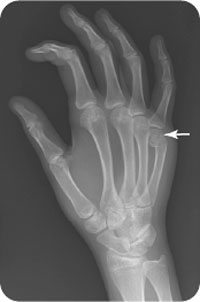George M. Bridgeforth, Jessica Peelman, and Charles Carroll IV
A 15-year-old female adolescent punches a wall. She complains of severe pain, swelling, and tenderness of her right hand, with pain-limited range of motion.

CLINICAL POINTS
- Most commonly, the ring and/or small metacarpals are affected.
- Volar (palmar) displaced metacarpal heads may produce a depression at the knuckles and palpable metacarpal head in the palm.
Clinical Presentation
Boxer’s fractures are fractures of the metacarpal neck, usually the fourth or fifth metacarpal heads—the ring and small metacarpals most frequently. Fifth metacarpal injuries are more common. The fourth and fifth metacarpal bones are smaller in diameter than the other metacarpal bones in the hand, and thus they are more vulnerable to injury. Boxer’s fractures follow a 10% rule: 10% of all fractures affect the hand and 10% of all hand fractures affect the fifth metacarpal. Therefore, 1% of all fractures are Boxer’s fractures of the fifth metacarpal. These fractures are characterized by the volar (palmar) displacement of the metacarpal head. The mechanism of injury generally is direct trauma—after throwing a punch or striking an object with one’s fist. However, they can also result from heavy objects striking the hand.
Clinically, patients present with marked pain, swelling, and tenderness at the fracture site. In addition, because of the volar displacement of the metacarpal head, there is a depression deformity (sunken knuckle) at the fracture site. Moreover, the depression deformity is accentuated when the patient tries to make a fist. Usually, there is pain-limited range of motion and pain-limited grip strength. It is not uncommon for the patient to hold the injured hand with the opposite hand.
It is important to assess the neurovascular status (warmth, capillary refill, and sensation of fingers) carefully. The physician should also check for rotational deformities of the metacarpals (each finger should point to the scaphoid when the fist is clenched). Normally, when a patient makes a fist, the fingers should be uncrossed and each finger should point to the scaphoid. If the fingers cross or “scissor,” there is a rotational deformity of the metacarpals. In addition, it is necessary to inspect the hand thoroughly for open wounds or human (“fight bite”) marks. Untreated human bites may lead to serious infections (see section, “Treatment”). Patients with diabetes warrant very close monitoring.
PATIENT ASSESSMENT 
- Marked pain, swelling, and tenderness at the fracture site (usually at the necks of the ring and/or small metatarsals)
- Range of motion and grip strength limited by pain
- Possible inability to make a fist
Associated hamate fractures are uncommon but are characterized by wrist tenderness proximal to the fifth metacarpal. The neurovascular examination with an associated hamate injury should document any ulnar nerve damage because it passes through Guyon’s canal.
NOT TO BE MISSED 
- Associated carpal fracture with severe injuries, especially the hamate
- Dislocation of the metacarpophalangeal or carpometacarpal joints
- Open fractures or bite marks (“fight bite”) (high risk of infection)
Stay updated, free articles. Join our Telegram channel

Full access? Get Clinical Tree








